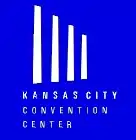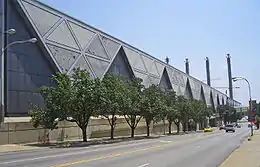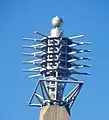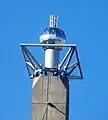 | |
 | |
| Location | Kansas City, Missouri |
|---|---|
| Coordinates | 39°5′51″N 94°35′16″W / 39.09750°N 94.58778°W |
| Operator | Kansas City Convention & Entertainment Facilities |
| Architect | Helmut Jahn |
| Opened | July 8, 1976[1] |
| Expanded | 1994 |
Construction cost | $91.7 million |
Theatre seating |
|
| Enclosed space | |
| • Total space | 800,000 square feet (65,032 m2)[2] |
| • Exhibit hall floor | 388,800 square feet (36,121 m2) (Bartle Exhibition Hall)[3] 46,000 square feet (4,274 m2) (Municipal Exhibition Hall)[4] |
| • Breakout/meeting | 118,000 square feet (10,963 m2)[5][6] |
| • Ballroom | 65,000 square feet (6,039 m2)[7][8] |
| Website | |
| www | |
The Kansas City Convention Center, originally Bartle Hall Convention Center or Bartle Hall, is a major convention center in downtown Kansas City, Missouri, USA. It was named for Harold Roe Bartle, a prominent, two-term mayor of Kansas City in the 1950s and early-1960s. Its roof is suspended by four tall art deco inspired pylons, as a component of the Kansas City skyline.
Overview
Kansas City Convention Center is Kansas City's largest complex of multifaceted structures dedicated to meetings and conventions, sports and entertainment. It offers 388,800 square feet (36,120 m2) of column-free exhibit space on one floor, 211,000 square feet (19,600 m2) of tenant finishes, a 200,000-square-foot (20,000 m2) conference center, another 55,000 square feet (5,100 m2) of additional space on two levels, 45 meeting rooms, a 2,400-seat fine arts theater, and an arena that can seat over 10,700 people, along with a 46,450-square-foot (4,300 m2) ballroom that was scheduled for an April 2007 opening, all connected to major downtown hotels and underground parking by glass-enclosed skywalks and below-ground walkways. A unique Convention Center feature is the expansive Barney Allis Plaza, a public square ideal for outdoor receptions, festivals and concerts.
The interior finishes in the public access areas consist of granite flooring and stairs adjacent to Precast Concrete panels at the Main Entry with Carpet Tile in the Ballroom and Pre-functions. The Ballroom and Pre-function areas feature Metal Panels, wood panels, wood veneer and painted gyp wall surfaces as well as Fabric Wall Panels and Sculptured Glass Fiber Reinforced Gypsum (GFRG) Panels on the interior walls. The Sculptured GFRG Panels create a simulated wave pattern which ties into the water theme of the facility drawing from Kansas City’s origin at the nexus of the Kansas and Missouri rivers. The Grand Ballroom ceilings are finished out in Metal Panel’s bordered at the perimeter walls with Stretched Fabric. The Stretch Fabric ceilings are backlit by a sophisticated LED lighting system that can be programmed to rain the GRGF wall panels in color. The ceiling space also features concentric light fixtures ranging in size for 3 feet (36 in) to 50 feet (600 in) in diameter.
The nonpublic service areas for the project features over 3,000 square feet (300 m2) of Pantry/Kitchen space with 784 square feet (73 m2) of walk-in cooler and freezer space. Additionally there are 2 separate Beverage/Ice Service Rooms for catering personnel to service Ballroom functions. These service areas are sealed concrete and resinous flooring in the Kitchen areas with FRP and MDF veneer wall panels. The service area is accessed by 2 separate covered loading docks that can be accessed from the highway.
The exterior of the facility is highlighted by a 30 feet (360 in) high metal panel canopy over pavestone walkway at the main entry. This canopy also extends the full length of the East Elevation and is supported by Steel Columns and Fixed Blade Steel Sunshades. The Southern Elevation of the building again features a high canopy with Fixed Blade Sunshades and opens onto a Decorative Concrete Plaza designed by Jun Kaneko, a renowned Japanese ceramic artist. This Plaza is complemented by Architectural Precast Concrete retaining walls, concrete stairs and walkways along with decorative concrete monument light pole bases. The remainder of the site is Greenscape consisting of Sodded open area with some 50,000 Kewensis, Sedum and Vinca Minor plants along with thirty-four 4 feet (48 in) caliper Japanese Pagota and Honey Locust trees.
Pylons
The center sits above Interstate 670, suspended by steel cables supported by four 335 feet (102 m) tall concrete pylons.
The sculptures that crown the pylons, called Sky Stations, were designed by artist R.M. Fischer in 1994.[9] Each is made of aluminum and steel, approximately 24x15-feet in diameter, and between 20 feet (6.1 m) and 25 feet (7.6 m) in height. They were primarily inspired by the 1930s Art Deco chandelier and decorative design elements throughout the adjacent Municipal Auditorium. They were placed atop each pillar via helicopter.
Lightning damage was found to the easternmost Sky Station during an inspection in late 2015. The sculpture was removed for repair on May 8, 2016. The repair project cost $1.6 million, all but $250,000 of which was covered by insurance.[10] The repaired Sky Station was reinstalled on September 18, 2016, and electricians also installed 50 LED lights, as part of the downtown skyline.[11]
Construction
The expansion of Bartle Hall was a significant technical challenge. Construction of the additional convention space was built over a continuously open six-lane freeway, Interstate 670, which runs underneath the convention center. Construction required the installation of four 300 feet (90 m) tall pylons to support the facility's roof. The result was the creation of the largest, column-free convention environment in the world. The building also was designed and constructed to meet green building standards and achieved a LEED Silver rating, the first City of Kansas City, Missouri project to receive Silver LEED certification.
The general contractor for the project was Walton Construction. The site team included 2 LEED Accredited Professionals documenting and tracking materials, construction methods, recycling and waste management. Architects were HNTB Architects, BNIM; engineers were Henderson Engineers; and multimedia, acoustics, and IT were by Shen Milsom & Wilke.
The total project cost was US$91.7 million, and it was completed on schedule in July 1994.
Gallery
 The Center stretches across Interstate 670 in Kansas City.
The Center stretches across Interstate 670 in Kansas City. The Center is suspended above Truman Road and Interstate I-670.
The Center is suspended above Truman Road and Interstate I-670. The Center expansion, viewed from 16th Street.
The Center expansion, viewed from 16th Street. Pylons viewed from W. 12th Street
Pylons viewed from W. 12th Street A sculpture
A sculpture A sculpture
A sculpture A sculpture
A sculpture
See also
- Empire Towers, another artwork by Fischer located in Indianapolis, Indiana
References
- ↑ "Missouri Valley Special Collections : Item Viewer". Archived from the original on March 4, 2016. Retrieved January 31, 2015.
- ↑ "Kansas City Convention Center | Visit KC". September 27, 2019.
- ↑ "Bartle Exhibit Hall (A - E)".
- ↑ "The LEX".
- ↑ "Meeting Room Series 2100 and 2200".
- ↑ "Conference Center".
- ↑ "Grand Ballroom (2501)".
- ↑ "Meeting Room Series 2100 and 2200".
- ↑ Cole, Suzanne P.; Engle, Tim; Winkler, Eric (April 20, 2012). "50 things every Kansas Citian should know". Kansas City Star. Retrieved April 7, 2019.
- ↑ "Bartle Hall Sky Station Project" (PDF). City of Kansas City, Missouri. Retrieved March 30, 2019.
- ↑ "KCMOre Magazine". City of Kansas City, Missouri. Retrieved March 30, 2019.
- American Institute of Architects Guide to Kansas City Architecture & Public Art. (Copyright 2000). American Institute of Architects/KC. Retrieved August 11, 2007. (Page 21, Number 27)